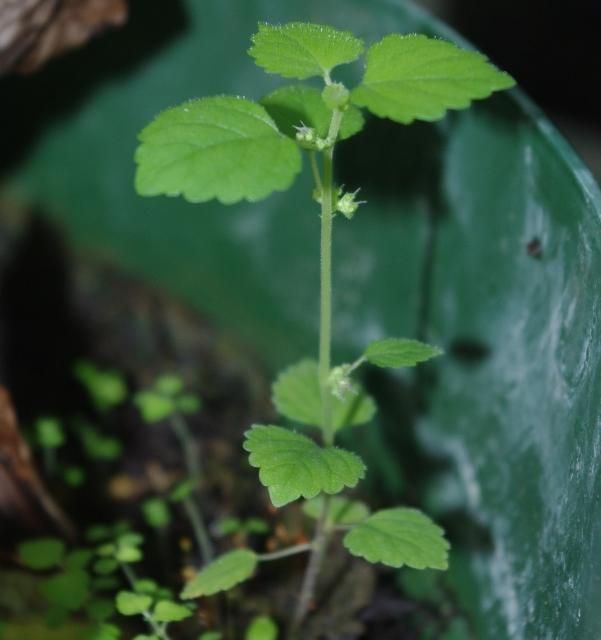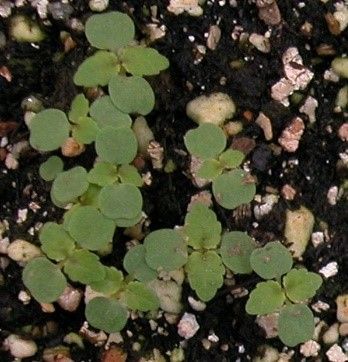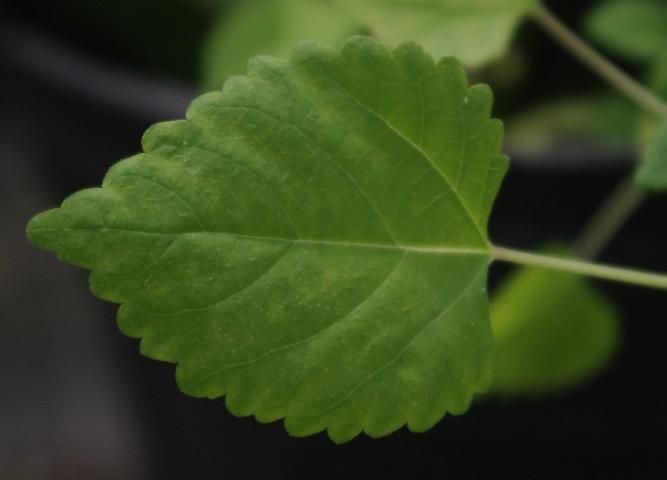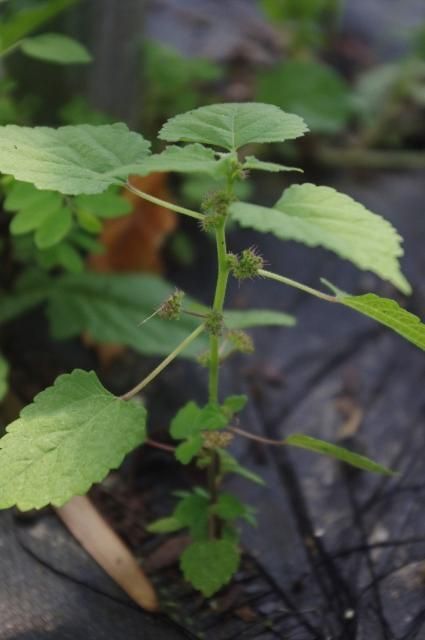Species Description
Class: Dicotyledonous plant
Family: Moraceae (mulberry family)
Other Common Names: Hairy crabweed, fatoua
Life Span: Summer annual
Habitat: Occurs in disturbed areas and wetlands; often found growing in landscapes, greenhouses, container pads, and nursery pots. It prefers to grow in irrigated or moist shaded areas.
Distribution: Mulberry weed is native to eastern Asia and was first reported in Louisiana in the 1950s (Bryson and DeFelice 2009). Mulberry weed has naturalized throughout much of the eastern United States and is found from Texas to Florida and north to Michigan and Delaware. It also occurs along the west coast from California into Washington (Gregory 2014; USDA NRCS 2014).
Growth Habit: Upright growth habit (Figure 1)

Credit: Annette Chandler, UF/IFAS
Seedling: Seedlings are dark to light green. Cotyledons are round and notched at the center. First true leaves are simple and slightly serrate (toothed) and triangular in shape (Figure 2).

Credit: Annette Chandler, UF/IFAS
Shoot: Stems are round, pubescent (hairy), and light green but can have a reddish to purple hue near the base. Shoot height can range from a few inches to over 4 feet. Leaves are simple, alternately arranged on the stem, papery in texture, pubescent, triangular to cordate (heart-shaped), and have serrate (toothed) margins (Figure 3).

Credit: Annette Chandler, UF/IFAS
Roots: Taproot
Inflorescence: Dense light green to purplish cymes (clusters) occur in leaf axils (Figures 4 and 5). Flower clusters begin turning dark brown as the plant ages.

Credit: Annette Chandler, UF/IFAS

Credit: Annette Chandler, UF/IFAS
Fruit and Seeds: Seeds (achenes) are light tan, oval, and about 1 mm in diameter (Wunderlin 1997). Some of the seeds are forcibly expelled when mature and can travel up to 4 feet away from the mother plant (Neal and Derr 2005).
Similar Species: When young, the mulberry tree (Morus alba) resembles mulberry weed. Mulberry tree also can be a problematic weed in nursery production and landscapes but grows much taller (up to 45 feet tall) and exudes a milky sap from young twigs when broken (Neal and Derr 2005). Another group of similar-looking species is galinsoga (Galinsoga spp.), which can be distinguished from mulberry weed by its white ray and yellow disc flowers.
Plant Biology
Mulberry weed occurs from spring to fall in Florida, primarily growing in moist, shaded areas. Plants flower from early spring through late fall and then die after the first freeze. Optimal temperatures for germination are approximately 70°F to 85°F, but seeds have been shown to germinate in temperatures ranging from 60°F to 100°F (Penny and Neal 2003). Seedlings may flower and fruit within 12 days of reaching the two-leaf growth stage (Neal and Derr 2005). Germination may be reduced in dry conditions; however, this is rarely seen since irrigation typically is applied regularly to nursery crops and landscapes.
Management
Physical and Cultural Control
Mulberry weed prefers moist soil conditions, but reducing irrigation is often impractical in a container-nursery setting. Due to the fast growth and prolific seed production, control efforts should focus on prevention and sanitation. Regularly scout container beds, greenhouses, propagation areas, and non-crop areas for presence of this weed. Closely inspect new plant shipments for presence of weeds. Hand pull mulberry weed as quickly as possible before it flowers. Remove pulled weeds from production areas or landscape beds and dispose of them, as seed can continue to be spread from pulled weed material if left on the soil. Mulberry weed germination is stimulated by light, therefore mulch materials placed on top of container media or in the landscape can significantly reduce seed germination. Pine bark nuggets applied at depths of 1.5 inches or more have been shown to provide up to 90 percent control (Penny and Neal 2003).
Chemical Control
Preemergence
Mulberry weed is effectively controlled with many preemergence herbicides but continues to be a problematic weed due to fast growth and prolific seed production. A list of preemergence herbicides labeled for use in and around ornamentals in nurseries and landscapes that can be used for mulberry weed control is provided in Table 1.
Postemergence
Many different postemergence herbicides will control mulberry weed, although these herbicides can be applied as only a directed application. Contact herbicides such as diquat (Reward®), and pelargonic acid (Scythe®) and systemic herbicides such as glyphosate (RoundUp®) will control mulberry weed, but these products are most effective when weeds are less than 4 inches tall and actively growing. When applying these herbicides, ensure that the herbicide spray does not drift or come in contact with any part of the ornamental plants.
References
Bryson, C. T. and M. S. DeFelice (eds.). 2009. Weeds of the South. Athens, GA: University of Georgia Press.
Gregory, N. F. 2014. Mulberry weed (Fatoua villosa). University of Delaware Cooperative Extension Factsheet. https://www.udel.edu/academics/colleges/canr/cooperative-extension/fact-sheets/mulberry-weed-fatoua-villosa/
Neal, J. C. and J. F. Derr. 2005. Weeds of container nurseries in the United States. Raleigh, NC: North Carolina Assoc. of Nurserymen, Inc.
Penny, G. M. and J. C. Neal. 2003. "Light, temperature, seed burial, and mulch effects on mulberry weed (Fatoua villosa) seed germination." Weed Tech 17:213–218.
USDA National Resources Conservation Service. 2014. "The PLANTS database." https://plants.usda.gov
Wunderlin, R. P. 1997. "Moraceae." In Flora of North America Editorial Committee, eds., Flora of North America North of Mexico. Vol. 3. New York: Oxford University Press. Pp. 388–392.
Table 1. Partial list of preemergence herbicides labeled for use in ornamental plant production and landscapes to control mulberry weed.